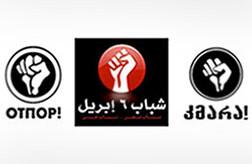Student-led protests in Serbia reached their peak this weekend [March 15-16, 2025] when more than 100,000 anti-government protesters gathered in Belgrade to demand the resignation of President Vucic. At the same time also some students and former paramilitary fighters loyal to President Vucic have been camping outside the presidency building in Belgrade from March 13, 2025 fueling fears of violent incidents during antigovernment rally this weekend. This could be
a provocation by the government to order police to quell the growing anti-government movement.
 A sticker with a message reading, “15.03. See you in Belgrade,” is seen on a tractor parked near the Serbian presidency building and the National Assembly in Belgrade. Credit: [Andrej Isakovic/AFP]
A sticker with a message reading, “15.03. See you in Belgrade,” is seen on a tractor parked near the Serbian presidency building and the National Assembly in Belgrade. Credit: [Andrej Isakovic/AFP]
The protests were sparked by the collapse of a railway station canopy in Novi Sad on November 1, killing 15 people (Background on this in my article -in Finnish- Serbiassa asemakatos romahti – 14 kuoli ). The station had been recently renovated under opaque infrastructure contracts – mainly including companies from Serbia and China, but reportedly also from France and Hungary – awarded under a credit agreement with China.
Serbian anticorruption protesters, riot police and supporters of President Aleksandar Vucic have faced off – so far -without major incident in central Belgrade as people gathered for the biggest antigovernment rally in years. At least 107,000 people from across Serbia have joined on Saturday 15 an anti-corruption rally in Belgrade, in what is regarded as the culmination of months of protest that have shaken the grip of the country’s autocratic president, Aleksandar Vučić, the interior minister reported.
Agence France-Presse reported that known ultranationalists, including members of a former militia linked to the assassination of then prime minister, Zoran Djindjic in 2003, have been seen among the group of activists camped near the presidential palace. Djindjic, who led street protests that deposed Slobodan Milošević in 2000, was assassinated 22 years ago this week by a paramilitary police group known by its unofficial name, the Red Berets. According Dragan Djilas, the leader of the opposition Freedom and Justice party, Vučić “has mobilised criminals, thugs and Red Beret members, bringing people from Kosovo and stationing them in Pionirski Park, knowing hundreds of thousands will gather there on Saturday”.
Near-daily student protests began in December, 2024, after the deaths of 15 people when a roof at a railway station collapsed on November 1 in the northern city of Novi Sad, which critics blame on corruption under Vucic. Sporadic clashes occurred overnight before Saturday’s rally, in front of the National Assembly, from which protesters were to march to Slavija Square. Police deployed hundreds of officers in full riot gear in and around Pionirski Park and across the street.Thousands of veterans from elite military brigades in maroon berets and bikers who support the students also stood for 15 minutes of silence beginning at 11:52am (10:52 GMT) to honor the victims of the Novi Sad tragedy at the time of the roof collapse.
A prelude: The overthrow of Milošević
Yugoslav and former Serbian President Slobodan Milošević was cracking down on opposition, non-government organisations and independent media. From 1991 onwards there were campaigns of civil resistance against his administration that were to culminate in the largely non-violent revolution of October 2000. In 1998, a dozen students met to form Otpor! ( “resistance”). Analysing the mistakes of the 1996–97 protests, they realised they needed more effective organisation, strategy, planning, recruiting, and everything necessary for a sustained fight. Galvanised by outrage over new laws that imposed political control of their universities and harassment of independent media, the Otpor! students called for the removal of Milošević and the establishment of democracy and the rule of law.
To unify opposition, eighteen parties in Serbia formed the Democratic Opposition of Serbia (DOS) coalition, with Vojislav Koštunica as the candidate to confront Milošević. The vote took place on 24 September 2000. The DOS coalition reported that Vojislav Koštunica won over half of the votes, enough to defeat Milošević in a single round. The government-controlled Federal Electoral Committee claimed that no candidate won over 50% of the votes and that a second round between Koštunica and Milošević would take place. Some obvious irregularities could be found in the Federal Electoral Committee official results.
The protests initially started with strikers at the Kolubara mines on 29 September, which produced most of Serbia’s electricity. The protest reached its height on 5 October 2000. Several hundred thousand protesters from all over Serbia arrived in Belgrade to protest. The key symbol of the campaign was the slogan Gotov je! ( meaning “He is finished!”), created by Otpor!. Unlike previous protests, there was no large scale police crackdown.
For a year leading up to the elections, the United States-funded consultants played a crucial role in the anti-Milošević campaign. The International Republican Institute trained 400 activists outside the country, who returned to Serbia and trained another 15,000 people to observe polling stations inside the country. Each observer’s participation was paid at $5 – money provided by the West (in 2000, the average monthly salary in the country was $30). Other Western organizations to support Otpor! were e.g. the Open Society Institute, the National Endowment for Democracy and Freedom House. Otpor! activists honed the lessons of nonviolent resistance developed by American scholar Gene Sharp and retired U.S. Army Colonel Robert Helvey. Most Serbs did not realize that the U.S. was directing the opposition’s electoral strategy and funding the creation and distribution of campaign materials.
Second act: From Otpor! To Color revolutions and Arab Spring
After the overthrow of Milošević Student-dominated youth movements have played a central role in the “color revolutions” seen in post-communist societies in recent years. Otpor! has inspired other youth movements in Eastern Europe, such as Kmara in Georgia, which played an important role in the Rose Revolution, and PORA in Ukraine, which was key in organising the demonstrations that led to the Orange Revolution. Like Otpor, these organisations have consequently practiced non-violent resistance in opposing authoritarian leaders. Similar movements include KelKel in Kyrgyzstan, Zubr in Belarus and MJAFT! in Albania. Serbia’s opposition organisation Otpor! has been involved in training students in civil disobedience in Georgia as well in over 20 other countries.

The uprisings witnessed throughout the Middle East have lent new credence to the power of youth movements and nonviolent resistance in authoritarian settings; youth activities from Egypt to Algeria have benefited from the lessons of their contemporaries in post-Communist Europe. Otpor! activists not only inspired, but shared insights with aspiring Egyptian revolutionaries in the years preceding the February 2011 changes..
There is evidence that Egyptian groups such as Kefaya, the April 6 Youth Movement, and Youth for Change built upon and adapted revolutionary models employed by young activists in Serbia, Georgia, Ukraine, and elsewhere. Adhering to the tenants of nonviolent resistance, their strategies and tactics evoked those so successfully employed by youth movements such as Otpor! in the run-up to the “color revolutions” of the early 2000s.
Act Three: From Vučić to Real Time
Aleksandar Vučić, who had previously been a member of Milošević’s Serbian Radical Party, founded the more moderate and pro-EU Serbian Progressive Party (SNS) in 2008 with Tomislav Nikolić. In 2012, Nikolić won the presidential election and was replaced by Aleksandar Vučić as party leader. The Progressive Party won a landslide victory in the elections in 2014, and Vučić was elected Prime Minister and in 2017 Vucic was elected president. The line of Prime Minister and then president Vučić’s populist government became increasingly authoritarian and restrictive of media freedom. Vučić also selects the t prime minister of Serbia and in practice holds the highest political power in his hands.
During Vučić rule Serbia has suffered from democratic backsliding into authoritarianism, followed by a decline in media freedom and civil liberties. Opposition figures accused the SNS of using public resources for political purposes and election monitor CRTA complained before the vote of a “chronic lack of pluralism” in Serbia. Recently government policy is characterised as one of human rights violations, restrictions on freedom of expression and campaigns of harassment against the opposition figures, journalists and media outlets. Today the largest political parties in the National Assembly are the populist Serbian Progressive Party and Socialist Party of Serbia, that with its partners, hold more than a supermajority number of seats.
President Aleksandar Vucic claimed a re-election victory in the country’s snap December 2023 elections, with his SNS, winning some 47% of the vote. Opposition parties under the Serbia Against Violence (SPN) banner were well behind with around 23%. The vote was almost immediately marred by accusations of irregularities. The International Election Observation Mission said in a statement that “serious irregularities, including vote-buying and ballot box stuffing were observed”.
Milos Vucevic, the leader of the ruling Serbian Progressive Party became prime minister in May 2024 and he resigned in January 2025 amid student-led anti-corruption protests following the November 2024 collapse of roof of a railway station in Novi Sad on 1 November, which killed 15 people. Vučić, widely seen to have sacrificed his prime minister to protect his position, has ruled out forming a transitional government and holding elections in six months. Echoing Russian narratives, he has described the protests as a western-orchestrated ploy to oust him from power and destroy Serbia.
Epilogue: My conclusions
The current protests in Serbia, if successful, could lead to the ouster of the country’s current president, especially if the student movement receives direct support from the broad middle class. What is essential for me to see is whether the situation will get worse, better, or remain the same without Vučić.
I would personally describe an Otpor!-type strategy as an anarchist but well-organized, military but non-violent method of organizing mass demonstrations, coups, or even revolutions. Post-coup governance is another matter entirely.
In the years that followed overthrow of Slobodan Milošević Serbia underwent a protracted transition that included the assassination of a reformist prime minister, the resurgence of the far-right Serbian Radical Party and a legacy of corruption and nepotism that continues to pervade its politics. Otpor! disbanded soon after Milošević’s departure. An intensely heterogeneous movement comprised of leftists and conservatives, monarchists and republicans, nationalists and cosmopolitans, Otpor! lost the glue that bound it together, Otpor! members could not agree on how to proceed.
The overthrow of Milosevic eventually led to the current situation, the Arab Spring, initiated by a liberal student movement, led to the rise of the conservative Muslim Brotherhood and then the military in Egypt. Iran’s “green movement” shrank when the government restricted the use of social media and the internet by urban youth, and when the uneducated rural population rushed to support the government.
Even in traditional constitutional states, mass demonstrations do not necessarily lead to results. For example, in Israel, I have participated in massive demonstrations in Tel Aviv several times before and during the current war. Despite legitimate demands and demonstrations involving hundreds of thousands of citizens every weekend for a couple of years, and despite the fact that, according to opinion polls, about 70% of the citizens support the demands of the demonstrators, power in Israel will not change until the current government loses its slim majority in the Knesset, either through internal factors or elections.
Lessons learned: Movements that are defined solely on the basis of a dictator’s ousting have little merit once that dictator is gone. Moreover, movements that fail to identify themselves in positive terms—as for something beyond the abstraction of “democracy,” rather than simply against a sitting regime—are unlikely to withstand the tests of time.
Sources e.g: The Guardian, From Resistance to Revolution and Back Again: What Egyptian Youth Can Learn From Otpor When Its Activists Leave Tahrir Square, Carnegie Council
Article first published in Conflicts by Ariel Rusila online publication

